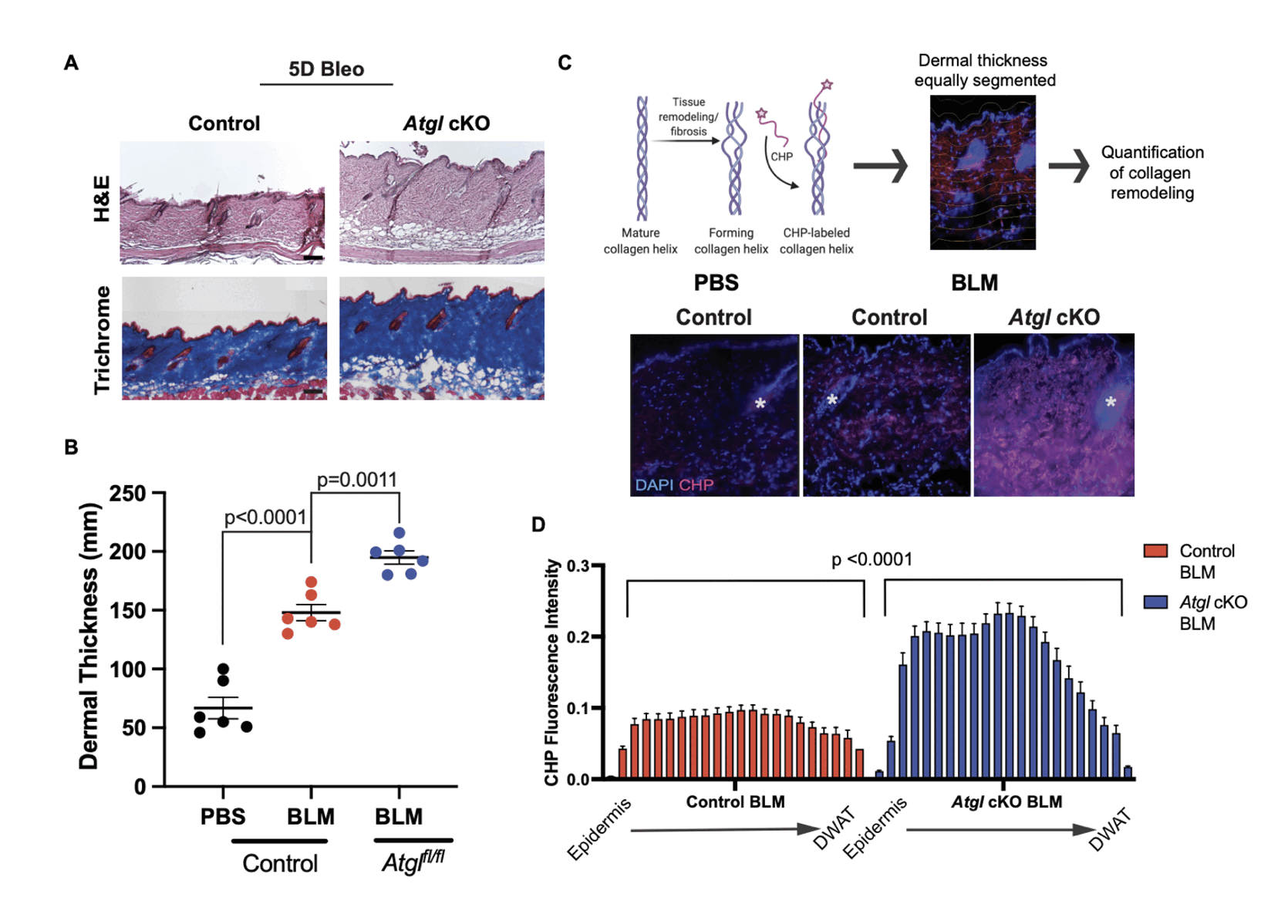Session Information
Date: Saturday, November 16, 2024
Title: Abstracts: Systemic Sclerosis & Related Disorders – Basic Science
Session Type: Abstract Session
Session Time: 1:00PM-2:30PM
Background/Purpose: Resident lipid-filled dermal adipocytes are depleted in both systemic sclerosis (SSc) and scleroderma mouse models, but mechanisms are poorly understood. We undertook studies in mouse models of fibrosis and in SSc patient biopsies to gain pathogenic insights.
Methods: Mice received daily subcutaneous Bleomycin (Bleo) or saline for 3, 5, or 11 days (fibrosis induction studies) or for 5 days with 0-, 5- or 10-day recovery (fibrosis resolution studies). Back skin sections were stained with H&E, trichrome, Oil Red O, and perilipin1A (Plin), a protein enriched in adipocyte lipid droplets, and slides were imaged. Using lineage tracing of GFP+ adipocytes in AdiponectinCreER;mTmG mice and immunofluorescence to assess adipocyte size and survival, we measured the size of labeled adipocytes and Plin1+ lipid droplets. To test whether lipolysis occurs contemporaneously with fibrosis, we deleted the rate-limiting enzyme of lipolysis, adipocyte triglyceride lipase (Atgl) by crossing AdiponectinCreER;mTmG mice with Atgl fl/fl mice (Atgl cKO). We examined the phenotype of these mice via analysis of adipocyte and lipid droplet size, lipid storage, collagen remodeling using a biotinylated collagen hybridizing peptide (CHP) that binds to regions of newly synthesized or remodeled collagen, and transcriptional analysis of differentially expressed genes in the Bleo-treated fibroblasts from Atgl cKO and control mice. Finally, we determined whether mRNAs for lipid metabolism and/or storage were altered in SSc skin and scRNA-Seq data from 6 SSc patients and 6 controls.
Results: We found that following Bleo treatment, dermal adipocytes and their lipid droplets decrease in size along with loss of lipid storage (but without increased cell death markers) in parallel with increased dermal thickness in 5-day bleo vs. saline-treated skin. Bleo-treated mice recovered from lipid storage reduction with increased Plin+ lipid droplets at 10d. Interestingly, genetic loss of Atgl in adipocytes resulted in precocious dermal thickening and increased CHP fluorescence in Atgl cKO compared to control mice after 5 days of Bleo treatment. Furthermore, we found that 30 out of 233 genes upregulated in SSc skin compared to health controls were involved with lipid metabolism including Acyl-CoA Thioesterase genes, phosphatidylcholine transfer protein, and phospholipid phosphatase 3. These transcriptional changes were confirmed in Single cell RNA-Seq data of fibroblasts in SSc patients.
Conclusion: Lipodystrophy of DWAT during fibrosis is dynamic: lipid loss occurs early in fibrosis and adipocyte enlargement accompanies fibrosis resolution. Inhibiting lipolysis through Atgl loss leads to DWAT lipid retention and precocious dermal thickening. SSc skin disease involves lipid processing and transport gene expression alterations.
a) Images of hematoxylin and eosin (H&E) or trichrome stained skin sections of Control or Atgl cKO mice after 5 days (5D) of Bleomycin treatment. Scale bars, 100mm.
b) Quantification of dermal thickness of skin sections from Control mice treated with PBS or Control or Atgl cKO mice treated with Bleomycin for 5 days. Data are 6 mice. Error bars indicate mean +/- SEM. p values calculated with one way ANOVA.
c) Schematic illustrating labeling and quantification of Collagen hybridizing peptide (CHP) fluorescent staining. Images of CHP (pink) and DAPI (blue) staining of skin sections of Control or Atgl cKO mice after 5 days (5D) of Bleomycin treatment. Scale bars, 100mm. Asterisks indicate autofluorescence in hair follicles.
d) Quantification of the fluorescent intensity of CHP staining of skin sections with the dermis segmented from the epidermis to the dermal white adipose tissue (DWAT) from Control or Atgl cKO mice treated with Bleomycin. Data are 3 mice. Error bars indicate mean +/- SEM. p values calculated with paired T-test.
To cite this abstract in AMA style:
Caves E, Dixit A, Jussila A, Lei V, Edelman H, Hamdan M, Odell I, Hinchcliff M, Atit R, Horsley V. Exploring the Link Between Atgl-Dependent Lipolysis and Dermal Fibrosis in Systemic Sclerosis [abstract]. Arthritis Rheumatol. 2024; 76 (suppl 9). https://acrabstracts.org/abstract/exploring-the-link-between-atgl-dependent-lipolysis-and-dermal-fibrosis-in-systemic-sclerosis/. Accessed .« Back to ACR Convergence 2024
ACR Meeting Abstracts - https://acrabstracts.org/abstract/exploring-the-link-between-atgl-dependent-lipolysis-and-dermal-fibrosis-in-systemic-sclerosis/

